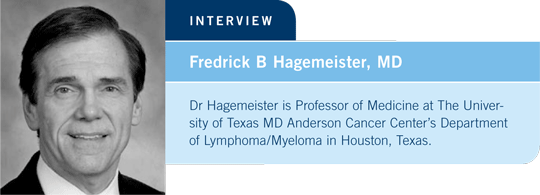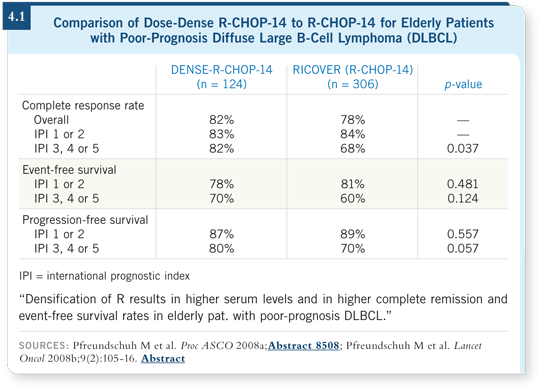

| Tracks 1-9 | ||||||||||||||||||||
|
Select Excerpts from the Interview
Tracks 2, 5
![]() DR LOVE: Can you discuss the trial of dose-dense rituximab with
CHOP-14 in elderly patients with diffuse large B-cell lymphoma
presented at ASCO 2008?
DR LOVE: Can you discuss the trial of dose-dense rituximab with
CHOP-14 in elderly patients with diffuse large B-cell lymphoma
presented at ASCO 2008?
![]() DR HAGEMEISTER: That trial demonstrated that if you administer rituximab
more frequently — two times a week — then higher rituximab levels are
sustained over a much longer period. Dose-dense rituximab also somehow
imparts a better response rate and disease-free survival rate among patients
with large-cell lymphoma (Pfreundschuh 2008a; [4.1]). The study was
conducted with patients older than age 60, which is the population in which
we’ve been using R-CHOP-14 clinically.
DR HAGEMEISTER: That trial demonstrated that if you administer rituximab
more frequently — two times a week — then higher rituximab levels are
sustained over a much longer period. Dose-dense rituximab also somehow
imparts a better response rate and disease-free survival rate among patients
with large-cell lymphoma (Pfreundschuh 2008a; [4.1]). The study was
conducted with patients older than age 60, which is the population in which
we’ve been using R-CHOP-14 clinically.
The caveat with this regimen is that you have to use trimethoprim/sulfamethoxazole and acyclovir as prophylaxis (Pfreundschuh 2008a), which we have not normally used with R-CHOP-21 but has been described by Memorial Sloan-Kettering with the use of standard R-CHOP-14. I’ve changed my practice — I use prophylactic trimethoprim/sulfamethoxazole and acyclovir for patients who receive standard R-CHOP-14.
![]() DR LOVE: Would you discuss the study design and results?
DR LOVE: Would you discuss the study design and results?
![]() DR HAGEMEISTER: It was a Phase II trial for which they selected patients
with high-risk disease (Pfreundschuh 2008a). They compared these Phase II
results to the results from their previous study (RICOVER-60) of R-CHOP-14 versus CHOP-14 (Pfreundschuh 2008b). The patients in the new study
who received dose-dense rituximab and had worse risk features, such as more
advanced disease, fared better. It was approximately a 10 percent improvement
in progression-free survival after a short follow-up (Pfreundschuh 2008a; [4.1]).
DR HAGEMEISTER: It was a Phase II trial for which they selected patients
with high-risk disease (Pfreundschuh 2008a). They compared these Phase II
results to the results from their previous study (RICOVER-60) of R-CHOP-14 versus CHOP-14 (Pfreundschuh 2008b). The patients in the new study
who received dose-dense rituximab and had worse risk features, such as more
advanced disease, fared better. It was approximately a 10 percent improvement
in progression-free survival after a short follow-up (Pfreundschuh 2008a; [4.1]).
I don’t know whether they’ll fall off eventually or how the data will ultimately appear. However, at an early point, it seems that using rituximab more frequently and obtaining higher rituximab levels in patients with large-cell lymphoma improve disease-free survival, time to relapse and other parameters (Pfreundschuh 2008a). Whether it will improve overall survival, I don’t know.

Tracks 7-8
![]() DR LOVE: Can you review what we know about bendamustine in follicular
lymphoma?
DR LOVE: Can you review what we know about bendamustine in follicular
lymphoma?
![]() DR HAGEMEISTER: The German data comparing bendamustine with rituximab
to R-CHOP that were presented at ASH 2007 were interesting. They
demonstrated that bendamustine/rituximab was as efficacious as R-CHOP in patients with a variety of different indolent lymphomas. The data indicated
a complete response rate of around 50 percent in patients with indolent or
mantle-cell lymphoma (Rummel 2007; [4.2]). They suggest a role for bendamustine,
particularly in combination with rituximab.
DR HAGEMEISTER: The German data comparing bendamustine with rituximab
to R-CHOP that were presented at ASH 2007 were interesting. They
demonstrated that bendamustine/rituximab was as efficacious as R-CHOP in patients with a variety of different indolent lymphomas. The data indicated
a complete response rate of around 50 percent in patients with indolent or
mantle-cell lymphoma (Rummel 2007; [4.2]). They suggest a role for bendamustine,
particularly in combination with rituximab.

Track 9
![]() DR LOVE: Where are we with bortezomib in lymphoma?
DR LOVE: Where are we with bortezomib in lymphoma?
![]() DR HAGEMEISTER: Evidence suggests that when you expose rituximab-resistant
cell lines to bortezomib, you can make those cell lines rituximab sensitive.
Evidence in cell lines also suggests that bortezomib is either additive or synergistic
in combination with chemotherapy and other drugs. Ongoing studies
are using rituximab with cyclophosphamide, bortezomib and prednisone
(R-CBorP) for indolent lymphomas, substituting bortezomib for vincristine
(Gerecitano 2008). Other trials are considering the addition of bortezomib
in the treatment of mantle-cell lymphoma, indolent lymphoma and large-cell
lymphoma.
DR HAGEMEISTER: Evidence suggests that when you expose rituximab-resistant
cell lines to bortezomib, you can make those cell lines rituximab sensitive.
Evidence in cell lines also suggests that bortezomib is either additive or synergistic
in combination with chemotherapy and other drugs. Ongoing studies
are using rituximab with cyclophosphamide, bortezomib and prednisone
(R-CBorP) for indolent lymphomas, substituting bortezomib for vincristine
(Gerecitano 2008). Other trials are considering the addition of bortezomib
in the treatment of mantle-cell lymphoma, indolent lymphoma and large-cell
lymphoma.
| Table of Contents | Top of Page |
EDITOR
Neil Love, MD
INTERVIEWS
Steven D Gore, MD
- Select publications
Michael J Keating, MB, BS
- Select publications
William I Bensinger, MD
- Select publications
Fredrick B Hagemeister, MD
- Select publications